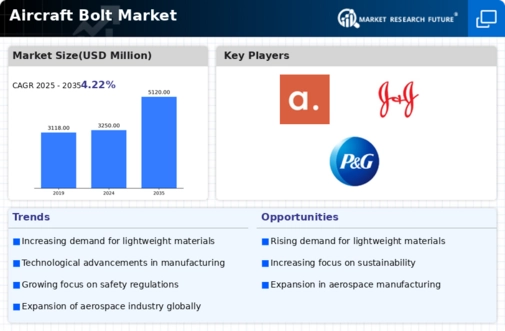Increasing Aircraft Production
The Global Aircraft Bolt Market Industry is experiencing growth driven by the rising demand for new aircraft. As global air travel continues to expand, manufacturers are ramping up production to meet this demand. In 2024, the market is projected to reach 3250 USD Million, reflecting the industry's response to increased orders from airlines and defense sectors. This surge in aircraft production necessitates a corresponding increase in the supply of aircraft bolts, which are critical components in ensuring structural integrity and safety. The trend suggests that as production rates rise, the demand for high-quality aircraft bolts will likely follow suit.
Emerging Markets and Globalization
Emerging markets are playing a pivotal role in the growth of the Global Aircraft Bolt Market Industry. Countries in Asia-Pacific and Latin America are witnessing a surge in air travel, prompting investments in new aircraft and infrastructure. This globalization of the aviation sector is creating opportunities for manufacturers of aircraft bolts to expand their reach. As these markets develop, the demand for aircraft bolts is expected to rise, driven by both commercial and military aviation needs. The increasing presence of global players in these regions may further stimulate competition and innovation within the market.
Growth of the Aerospace Aftermarket
The Global Aircraft Bolt Market Industry is also benefiting from the expansion of the aerospace aftermarket. As aircraft age, the need for maintenance, repair, and overhaul (MRO) services increases, leading to a heightened demand for replacement parts, including aircraft bolts. This trend is particularly relevant as airlines seek to extend the lifespan of their fleets while ensuring safety and performance. The aftermarket segment is expected to grow significantly, contributing to the overall market expansion. With the increasing focus on maintaining operational efficiency, the demand for high-quality aircraft bolts in the aftermarket is likely to remain strong.
Market Trends and Growth Projections
The Global Aircraft Bolt Market Industry is poised for substantial growth, with projections indicating a market size of 3250 USD Million in 2024 and an anticipated increase to 5120 USD Million by 2035. This growth trajectory suggests a compound annual growth rate (CAGR) of 4.22% from 2025 to 2035. The market trends reflect a robust demand for aircraft bolts driven by factors such as increased aircraft production, technological advancements, and regulatory compliance. These trends indicate a dynamic and evolving market landscape, where manufacturers must adapt to changing demands and innovate to maintain competitiveness.
Technological Advancements in Materials
Innovations in materials science are significantly impacting the Global Aircraft Bolt Market Industry. The introduction of lightweight, high-strength materials such as titanium and advanced composites is enhancing the performance and durability of aircraft bolts. These advancements not only improve fuel efficiency but also contribute to overall aircraft performance. As manufacturers adopt these new materials, the market is expected to grow, with projections indicating a rise to 5120 USD Million by 2035. The shift towards more sophisticated materials may also lead to the development of specialized bolts that cater to specific aircraft requirements, further driving market expansion.
Regulatory Compliance and Safety Standards
The Global Aircraft Bolt Market Industry is heavily influenced by stringent regulatory compliance and safety standards imposed by aviation authorities worldwide. These regulations mandate the use of certified materials and components, including aircraft bolts, to ensure the safety and reliability of aircraft. As regulations evolve, manufacturers are compelled to invest in high-quality bolts that meet these standards, thereby driving market growth. The emphasis on safety and reliability in aviation is likely to sustain demand for aircraft bolts, contributing to a projected CAGR of 4.22% from 2025 to 2035. This focus on compliance ensures that the market remains robust and competitive.














Leave a Comment